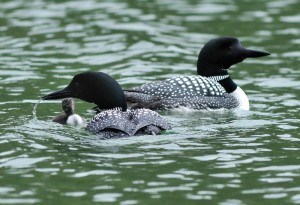
Loons nesting soon on Pyramid Lake
It’s another welcome sign that spring has arrived: the hauntingly beautiful call of the common loon. Pyramid Lake is a likely place to hear this call, and perhaps even spot the striking bird, with its black and white checkered back, glossy black head and white belly and wing lining. Each year, loons return here from the coast to nest and rear young. They arrive in pairs in spring as soon as the ice thaws—usually by the third week in April.
The best sites for loon nests are completely surrounded by water, such as on an island, a half-submerged log, or a clump of grass-like water plants. To help loons nest and rear, Parks Canada has for the past several years erected a floating nest and signs asking boaters to avoid the outlet bay near the nesting site. Each year since the floating nests and signs went up, researchers have observed chicks. Before this, the loons did not produce any.
The new chicks will be able to swim right away, sometimes spending time on mom or dad’s back to rest, conserve heat, and avoid predators. It can take two or three months before the chicks fly.
So, remove your ear buds, grab your binoculars and head to the shores of the far end of Pyramid Lake to look for these amazing birds that call our park home.
Alas, spring is also avalanche season
If you’re planning to travel the Icefields Parkway or Maligne Road this month, please note that at this time of year (usually until the end of April), these roads can be temporarily closed for avalanche hazard and control work. The much welcomed warm and sunny weather, or moderate to heavy spring rains, can quickly raise the avalanche hazard. When this happens, Parks Canada will temporarily close roads to ensure motorists’ safety until the avalanche hazard is mitigated by either cold overnight temperatures (which stabilize the snowpack) or by avalanche control actions.
To help avoid closures, travel the Icefields Parkway or Maligne Road early in the day, and aim to have travelled beyond slide areas before mid-day.
Slide areas are:
- Icefield Parkway—from the Parker Ridge Trailhead in the north to the Saskatchewan Crossing in the south.
- Maligne Road—all points south of the Medicine Lake outflow.
Check the road report for the most recent information on planned closures and expected opening times before heading out. Jasper National Park’s Road Report Information line is 780-852-3311. The Road Conditions Report can be found on the website at www.pc.gc.ca, or check Alberta’s Official Road Reports at www.511.alberta.ca.
Additionally, you can find information on planned avalanche control work in the latest avalanche bulletin, and get an idea of the expected avalanche hazard in the coming days to help with travel plans at www.avalanche.ca.
Parks Canada
Special to the Fitzhugh
